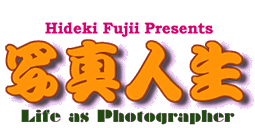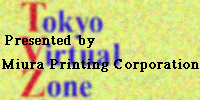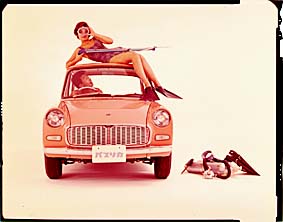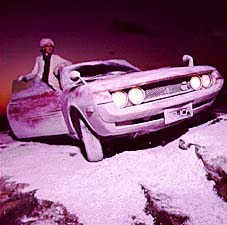TopMenu
 Supported by
Supported by

Mr. Hideki Fujii has played an important role in the world of advertisement photography and ladies' portraits for many years. Recently he has published printed works on photo emulsion for Japanese paper.
Introducing the story of ' a photographer's life', a Mr. whose experience has extended over 40 years .
 Editor (below initialled Ed): Thankyou very much for giving up your precious time,...
Editor (below initialled Ed): Thankyou very much for giving up your precious time,...
Mr. Hideki Fujii: Last time I talked about the lady's lifestyle magazine
period, but this time I'd like to continue but talk about the period after I
moved to the Japan Design Centre in 1960. I dealt mainly with Toyota Motor
Co. and Asahi Kasei, but in the latter half it became mostly Toyota. The designers that I partnered up with were Doctors Kazumitsu Tanaka and Kazumasa Nagai.
I wasn't just about taking photos of cars. In Japan, the first thing is to
take a picture of the car in the studio and the person who established this
know-how was myself.
In the studio where we shot a series of photos of the car, in Japan it was a
case of no-one knowing how to photograph a car or what lighting methods one
should use.
I read various foreign magazines and studied about lighting. I bought a mina
ture metallic car and with a pencil light I would play around with it until
late every night seeing how the light would hit it and learnt how to create
the most beautiful picture.
As a result, the method I can think of is, I intercepted the light by wrapping it in a big piece of material and I took the photo with the light reflecting off the wall. In those days revised techniques weren't heard of so it was hard work trying to achieve a beautiful creation. At this time, I bought a
material from Asahi Kasai and hung it from the ceiling, killing the light reflections. This was the Publica release's advertisement but even now that me
thod is still being used.
After about 10 years after I went freelance, I had another car job but during this time I had more fashion work so they thought that it was my first car shoot, so they told me 'in the studio there is a large white piece of material so feel free to use it' and also there were people telling me various methods to use.
I stayed in a Japanese inn called 'Takeen'(Bamboo Garden) in Nagoya for a month and took photos of a new car created on a test course. If news of this car's release had been exposed, nobody would have been able to buy it. Toyota
kept a lot of it's stocks wrapped up, so everything about this car was a complete secret. At this time, Toshiyuki Kajiyama's 'Black test run car' became a topic, and even became a film so the checks became accelerating stricter
and even the number of negatives were checked.
We also often went on location, going to Nikko, Akagiyama and the likes. Because of catalogues, we had to take go to various places to take the photographs, and to get the right suiting background for the car was pretty difficult. One time when I had to take pictures of a car running, it meant I had
to take them from the carrier of a freight truck and then went on a crane and took pictures looking down, because of the shaking I really felt I had put
my life on the line. One time one morning not far from Akagiyama,when I was
taking photos on top of a frozen lake, half of the car slipped into the lake
and I just went blue. Luckily another car pulled it out, and it ended up ok,
but the new car was so close to sinking ing the lake!!
 Also, a designer drew up a picture conte of taking photographs of a dump truck from under another dump truck using a low angle. On a burning hot sunny day, I posed with the camera at a low angle under the dump truck, however the
muffler ran above me so it was so hot and unbearable. The designer just drew the picture conte but for the photographer it was like hell.
Also, a designer drew up a picture conte of taking photographs of a dump truck from under another dump truck using a low angle. On a burning hot sunny day, I posed with the camera at a low angle under the dump truck, however the
muffler ran above me so it was so hot and unbearable. The designer just drew the picture conte but for the photographer it was like hell.
The impression that sticks with me most about the design centre working period was when I photographed the world's top model of that time 'Twiggy'.
Under Tokyo Tower at that time, a studio where it was possible to take photographs of cars had been completed named 'Parks Studio', and there we took the photographs for the 'I love Corona' copy advertisement. She was the most
popular model so there were scores of bodyguards, and ended up being a total
of about 50 staff. Within a short time, I had to take loads of photographs so using amounts of differing materials - lighting and stage equipment, it became a difficult and bigscale photographic shoot. She was a very smart and perceptive girl but as soon as you made eye contact, she would move away.
Actually at that time, I made a huge mistake. I shot using tungsten light, and I don't know why there was something like day light in the film, but why
I let on is that everyone ended up with red eye and I was shocked. (laugh) I
still don't know thereason but, but from then on I became incredibly careful
with film. However, when I think of it now, working at the Japan Design Centre, learning methods of producing the magazine called 'dress' and working with famous designers, really was helpful for me when I went out freelancing.
I think I was very lucky that I could build up contacts like that.
Last month from the 23rd to the 28th, a photographic exhibition more like a
total collection of works was held at the Mitsukoshi Department Store. For
this reason, I got out all my old negatives and tried to put them in order.
I came across my works from the Design Centre period, and I thought back fondly of that time, and I think it made me revise those methods again.
Talking of which, I was at the Design Centre for 3 years before Kazumitsu Tanaka gave his notice and went out on his own. Around that time I too was busy working part time at the fashion magazine company so in 1963 I left the Design Centre and went out freelancing. At the Japan Design Centre, I learnt
many things and the fact that I was able to be employed in this kind of work
in the beginnings of advertisements makes me feel very appreciative.
Ed: I hear you're going to tell us about the Akasaka studio era next time.
We'll look forward to it, thank you very much.


 Editor (below initialled Ed): Thankyou very much for giving up your precious time,...
Editor (below initialled Ed): Thankyou very much for giving up your precious time,... Also, a designer drew up a picture conte of taking photographs of a dump truck from under another dump truck using a low angle. On a burning hot sunny day, I posed with the camera at a low angle under the dump truck, however the
muffler ran above me so it was so hot and unbearable. The designer just drew the picture conte but for the photographer it was like hell.
Also, a designer drew up a picture conte of taking photographs of a dump truck from under another dump truck using a low angle. On a burning hot sunny day, I posed with the camera at a low angle under the dump truck, however the
muffler ran above me so it was so hot and unbearable. The designer just drew the picture conte but for the photographer it was like hell.